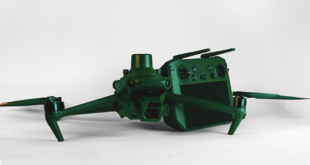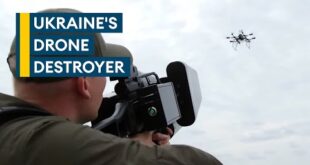The room at Delta Junction Junior High School would look busy even without the nine students zipping around. The buzz from the kids just added to that busy-ness.
Nick Adkins easily got their attention, however. He was visiting to teach them some things about drones — and not only the small quad-copters these kids are familiar with.
Adkins is operations director of the Alaska Center for Unmanned Aircraft Systems Integration at the University of Alaska Fairbanks Geophysical Institute. His visit to the Delta school — home of the Grizzlies — was part of ACUASI’s effort to get young people interested in science, technology, engineering and math.
Adkins, usually with another ACUASI team member, has traveled throughout Alaska on the center’s outreach mission.
Delta Junction is just one of many stops on Adkins’ flight path. He has made several trips to Galena, a Yukon River community 270 miles east of Fairbanks and off the road system. He visited with students at the local district’s Sidney C. Huntington School and with those of the Galena Interior Learning Academy, which attracts students from around Alaska.
Adkins has also made repeat visits to Camp Fire Alaska, 750 miles south of Fairbanks at Cooper Landing on the Kenai Peninsula, and talked with students in Nenana, about an hour drive southwest of Fairbanks. He also hopes to visit Nulato, a community downriver from Galena.
“The real fun is seeing that light bulb go on,” Adkins said. “You see a child who really hasn’t been exposed to things like this, and you give them this drone to build with these tiny, frustrating parts, and they just seem to shine. And all of a sudden this child has got all these pieces and parts in front of them, and the next thing, you know, they’ve got a flying drone.
“You see them realize that they just found something they’re good at and that they didn’t know they were good at it, because maybe they didn’t grow up in a family that works on things,” he said. “People grow up in different ways.”
The students ACUASI reaches today can be on the path to a job in the blossoming field of commercial drones, Adkins said. He mentioned his visit to Galena as an example.
“These kids are 14 and 15 years old, and they have a real chance of working in the drone industry when they get out,” he said. “There’s a young man there who was going to graduate with his drone pilot’s license. I could have hired him directly out of high school.”
For four days in mid-July, Delta junior high librarian Norm Cosgrove was running a summer school session about drones.
On day No. 2, Cosgrove turned over the school’s Creative Cafe to Adkins. The Creative Cafe is a single expansive room that houses the library, art classes and the innovation station, which includes a 3D printer and Cricut cutting machines.
Before setting the students loose on the drone flight simulators on two laptops, Adkins walked them through the training and regulation side. It’s not as flashy as a simulator or handling a small drone, but the students — seated on and around a couch — knew they needed to pay attention. Hands often went in the air when Adkins asked a question or talked about what they needed to learn to pass the Federal Aviation Administration’s test for recreational drone pilots.
There’s more to this summertime learning about drones than just drones. Cosgrove said that, although the days of learning about drones feels like a camp, it’s considered actual summer school because the curriculum contains math, reading and writing.
Cosgrove also runs the school’s Flight Club, which got started after a student came to him in 2011 for help assembling a drone that was a Christmas present.
“We’ve been involved with ACUASI for quite a few years,” Cosgrove said. “It’s great for these kids to actually see what drones can do and the careers that are possible with drones.”
Cosgrove pointed to one of the students.
“The young gentleman here is planning on using drones at his family’s farm,” he said. “These are 12- and 13-year-old kids thinking of ways to use this technology.”
Cosgrove also brings the students — those in the summer school as well as those in Flight Club — to ACUASI’s hangar on the East Ramp of Fairbanks International Airport. That’s where they can see ACUASI’s main aircraft: SeaHunter, with a 16-foot wingspan, and Sentry, with a wingspan of just under 13 feet.
A visit to Fort Yukon, about 150 miles north of Fairbanks, showed an added benefit of ACUASI’s outreach: spending time separately with adults after working with the students.
“We stayed well into the evening so that the community could come in and see what we’re up to,” Adkins said.
Funding for the outreach comes from the Federal Aviation Administration and from ACUASI.
The FAA relies on partners to help spread the word about aviation, and one of those methods is the agency’s Science, Technology, Engineering and Math Aviation and Space Education Program.
ACUASI has its own reasons for wanting to connect with the public, especially young Alaskans.
“We want to provide value to the state of Alaska,” Adkins said. “Are we working on an actual problem that needs to be solved, for example. We think large cargo delivery is a problem in Alaska. That’s what ACUASI has been focused on, and we think these students that we’re talking to can work in this industry.”
 Unmanned Aerial Vehicle The latest drone news
Unmanned Aerial Vehicle The latest drone news


